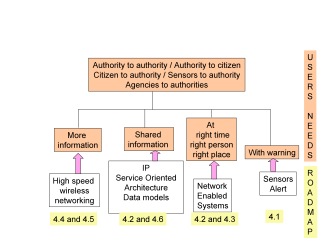| Technology Assessment and Road Mapping | | Print | |
|
The preparation of the R&D roadmap for future public safety communications started with a review of the state-of-the-art of ICT for public safety. A list of relevant background technical material was established, reviewing the following technological aspects:
It was complemented by an initial section of system level issues, as this approach is one of the enablers to be able to integrate in the public safety domain components (equipment or software) but also actual systems (data management or telecommunications systems) that are based on standard or off-the-shelf technology.
The R&D roadmap for future public safety communications was transferred to the PSCE Forum in May 2009. The document is the result of an iterative process, including the discussions held within the PSCE Forum initiatives, and identifies the following key technology items for future public safety:
As a summary, information is exchanged between authorities, between authorities and citizens, between agencies and authorities and between sensors and authorities. From the user needs described in EC projects and other documents, users today want to get more information, be able to share it, and get it at the right time, the right place for the right person.
Key related technologies are summarized in the attached document with the link to the sections in the document D2.5 available on the project depository. The mapping of technologies identified as key in the R&D roadmap was performed on two scenarios selected from the SAFECOM report ([1] Public safety Statements of Requirements for communications and interoperability - Volume1 - Version 1.2.2006): ‘Terrorist car bomb attack with Emergency medical service’ and ‘Chemical plant explosion’. The ‘Terrorist car bomb attack’ scenario is depending of location and size and it can be with cross border implications, it includes present and future technologies and involves many national (and international) COIs from police, jurisdiction, fire fighters, emergency teams... Mobility and interoperability are key issues and its use cases, are reusable in many other scenarios. The ‘Chemical plant explosion’ scenario focuses more on the command and control, asset status and tracking, and major communications interoperability aspects of an incident involving first responders. The scenario occurs from the perspective of the Information and Communication (IC) and Emergency Manager (EM), and does not include as much first person, first responder perspectives. Technology mapping to users scenarios needs to take into account:
Following the use cases in the scenarios, they clearly show the need for new technologies as:
The technologies are justified by the operational corresponding use case:
A Net Centric environment and architecture is the ultimate goal, with the right information to the right person at the right place.
|
